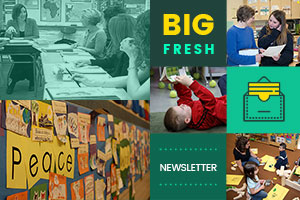Education has produced a vast population able to read, but unable to distinguish what is worth reading.
G. M. Trevelyan
Once upon a time, there was a third-grade girl, Daisy, who loved to read. She read all the time. While she liked to read about horses and outer space, she especially loved to read stories. She had read every single Magic Tree House, Junie B. Jones, and Amber Brown book ever written. Recently, she had been into reading books about animals and had read Shiloh and Charlotte’s Web.
One day, as she browsed through books at the school library, she found a book with a beautiful cover of a girl wearing glasses holding a comic book. When she saw it, she thought, “that girl looks like me!” She ran her fingers over the letters scrawled grandly across the cover and read the title aloud: Flora and Ulysses. It was then that she noticed a small animal tucked up in the corner which compelled her to read the back cover. As her eyes skimmed over the words describing a story about a squirrel who gets run over by a vacuum cleaner and strangely develops super powers, she opened the book and began to read.
Before she knew it, the librarian was shouting a last call to check out books. Daisy hurried to have her book scanned and joined the rest of the children lined up at the door to return to class. Ms. Wright, her teacher, walked up and down the line surveying the children’s choices. Every now and then she’d murmur things like, “Oh! Great author!” and “You’ll love this one.” By the time Ms. Wright arrived at Daisy she was nearly bursting with excitement. She couldn’t wait to tell her how she loved what she had read so far and she longed to hear her say what a great choice she had made choosing a book with a medal on the cover.
However, when Ms. Wright glanced at the book in Daisy’s hand, she looked between the book and Daisy and said, “Oh sweetheart, you’re going to need to return this book.”
Return this book? Did she hear correctly? Confused, Daisy looked at her teacher who kneeled beside her, looked regrettably into her eyes, and said, “You’re a level R. This book is much harder than that. Run and give this back. You can choose something from the R bin when we get back to the classroom.”
Crestfallen, Daisy handed the book back to the librarian. In her head, she kept hearing the echo of Flora’s voice speaking the same words she said when she witnessed Mrs. Tickham vacuum up the squirrel: Holy bagumba.
What was she going to read now?
Back in the classroom, Daisy dragged herself to the R bin and without even looking, grabbed the book that was on top. She returned to her seat and muttered the title: Captain Underpants and the Attack of the Talking Toilets. Grudgingly, she began to read…
Moral of the Story: Holy bagumba, don’t let reading levels flush away common sense.
This week we look at the tyranny of levels in elementary classrooms. Plus more as always — enjoy!
Contributors, Choice Literacy
Free for All
Here are two features from the archives on the limits of levels in reading programs.
Children might be missing out on great books that are a better fit if they are reading books based solely on a reading level. Shari Frost delivers a smart reminder about challenging advanced readers in Just Because They Can Doesn’t Mean They Should:
http://www.choiceliteracy.com/articles-detail-view.php?id=89
Franki Sibberson considers when levels matter as teachers group students for instruction:
http://www.choiceliteracy.com/articles-detail-view.php?id=573
A celebration of graphic novels has just been launched on the web, and will run throughout October. Here’s how you can join in on the fun:
For Members Only
Jan Burkins and Kim Yaris consider the insignificance of what levels convey about young readers in Unstable Labels: Stop the Race to Z:
Katie DiCesare moves beyond levels to consider her first-grade readers’ needs in Little Levels, Big Thinking:
This week’s video is the second installment in our series on teaching the difference between nonfiction and fiction in first grade:
http://www.choiceliteracy.com/articles-detail-view.php?id=1740
Katrina Edwards finds observation and inventories are incredibly useful for assessing learning in Reading, Engagement, and Kidwatching:
http://www.choiceliteracy.com/articles-detail-view.php?id=2283
In an encore video, Gail Boushey and Joan Moser (“The Sisters”) explain the value of Flexible Groups: Moving Beyond Levels to Assess Reading Needs:
http://www.choiceliteracy.com/articles-detail-view.php?id=22
That’s all for this week!



